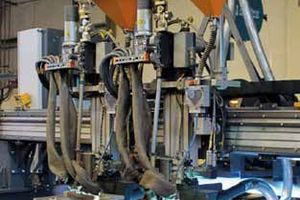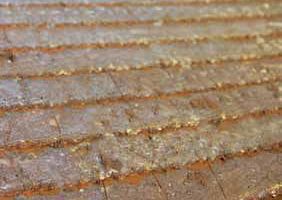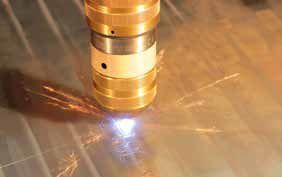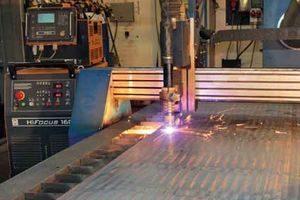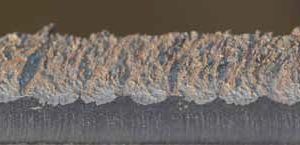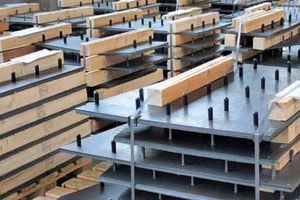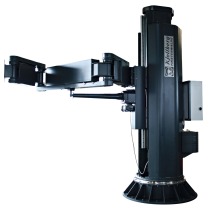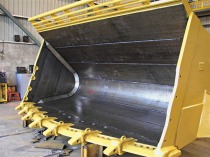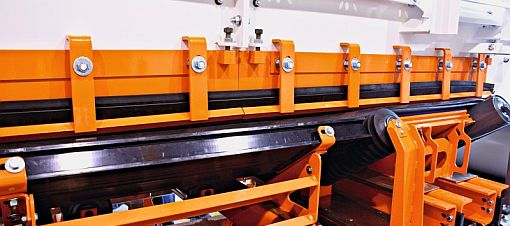Wear protection for high reliability
Drilling rigs weighing hundreds of tonnes, giant excavators, crushers as high as a house, screens, separators, mile-long conveyor systems – all of them are settled in an area the size of a small town. Closely interconnected, they haul ores into the light of day around the world, day in and day out. The reliability of the technology is essential to ensure that this mechanism keeps working properly, with the most demanding requirements in the area of protection against wear. Whether rolling, sliding, hitting or scratching – hard mineral rocks lead to a loss of material on the surface of the tools and transport equipment and are very demanding on the systems.
Minimising this wear is the job of specially coated surfaces or steel sheets which have been structurally changed using thermal or thermo-mechanical processes to prepare them for the specific requirements encountered in the mining industry. The essential factor is the optimum interaction of the properties of hardness and toughness – depending on the type of impact on the surface.
The feed hopper of a crushing plant is exposed primarily to shock forces, but also to sliding forces. That is why it is lined with wear plates made of the special steel Hardox. For each of the segments, which are up to 1.5 m2 in size, specially rolled 32 mm sheets are cut to size and drilled with counterbore holes for fixing to the substructure. These detachable connections ensure that the sheets can be replaced during subsequent maintenance without major effort. To equip a hopper the size of a family house, about 200 tonnes of material are processed in this way.
After processing in the crusher, the rocks are fed on a slat conveyor to the next stage of processing. Because of the reduced grain size, pronounced shock-slide wear is also to be found here. The conveyor system is therefore lined with impact plates. Kjellberg at Finsterwalde/Germany manufactures these lining plates in a range of different dimensions, with a hardness of 60 HRC in accordance with the drawing, and ready for assembly.
First, 10-millimetre metal plates are coated with two layers of 10 mm hard facing of the Kjellberg quality Fidur 10/65. The Fidur surfacing equipment (Fig. 1) can coat plates up to a size of 1500 x 3000 mm (4.5 m2). The welding is done with an open arc, to which a flux is added to achieve the required material properties. For each square meter of sheeting, 30 kg of welding wire type KF S2 and 50 kg of flux are used. The flux is a special mixture of three components produced by Kjellberg Finsterwalde specifically for this type of load. Alternatively, the significantly more expensive flux-cored welding procedure could also be used for this purpose.
As the power source, two parallel GTH 1002 welding rectifiers are used. These systems work constantly with a welding current of up to 1000 amperes, which means that they are robust enough to weld long seams on large workpieces. The coated sheets (Fig. 2) correspond to the quality offered by Fidur 10/65 P, which means that they are highlyresistant to abrasive wear. Increased carbon and chromium content in the welding material is used to achieve a high level of hardness and wear resistance.
The two-layer coating of a 4.5 m2 metal sheet, including set-up and a short finishing time, takes about one work shift. The process is accompanied by loud banging: the tension produced in the weld beads during cooling leads to the cracks typical for cladding in the coated material, but does not affect the quality of the surface. Despite this reduction of tension in the weld beads, solid bracing on the welding table and an optimised welding process, the sheet warps due to the process-related high heat input. In order to provide the customer with parts in conformity with drawings and to ensure roughly right-angled cut edges during plasma cutting, the sheets are straightened in a rolling process. Their shape is restored by putting them through three rollers after cooling.
After hard facing, nearly 3000 individual sheets are cut to size in accordance with the drawings provided for the conveyor system. This is best done using thermal processes, because even cutting with a water jet, during which heat input into the material would be prevented, is not suitable: the speed of the process is too low, water and abrasive agents would have to be reclaimed or disposed of, and the direct contact with water would quickly lead to corrosion of the parts. Of the thermal processes available, plasma cutting is preferable because the laser beam is very cost-intensive and sensitive to unevenness, and autogenous technology cannot be used for marking.
For the cutting process (Fig. 4), the plate is placed with the hard side down to prevent entry of ma-terial from the hard coat layer into the base material. With a HiFocus 160i, the positions for the bolts to be welded on later and the drawing numbers are first marked (Fig. 3). With the same torch, the cutting of the different contours is then done using the most advanced HiFocus plasma cutting technology. The system cuts reliably, with excellent quality (Fig. 5) and a speed of 1200 mm per minute, with no dross. A height controller adjusts the torch distance from any unevenness remaining on the sheet.
In this manner, more than 500 m2 of material are processed into about 30 different impact plate geometries within a few weeks. Before the parts are packaged and shipped, the last step is the welding of bolts for fixing to the substructure (Fig. 6). This is also when the last inspection of the parts takes place. Before the bolts are welded, the contour is again compared with the drawing. The first quality check has already taken place after the build-up welding process. The material thickness tolerance is +/-2 mm. After the cutting process, the marking of the bolt positions is checked using templates, the penetration of the weld metal is inspected at the cut edges and the Kjellberg laboratory takes test specimens to measure the hardness of the weld metal. With this process, the company guarantees a long service life for the highly stressed components, thereby making an important contribution to the reliability of surface mining and other heavy-duty equipment.
Under the name Fidur, Kjellberg Finsterwalde offers products for wear protection across the entire value chain. Customers in many areas of heavy industry not only receive custom-made sheets, but can also purchase all of the equipment and welding material required for build-up welding. Also available are the regeneration of parts, a rental service for mobile systems and, of course, comprehensive advice and consultation.

